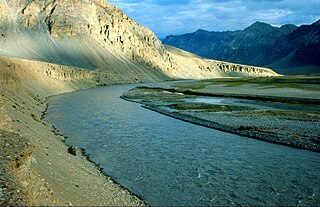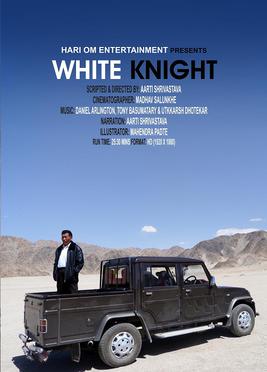
Ladakh is a region administered by India as a union territory and constitutes an eastern portion of the larger Kashmir region that has been the subject of a dispute between India and Pakistan since 1947 and India and China since 1959. Ladakh is bordered by the Tibet Autonomous Region to the east, the Indian state of Himachal Pradesh to the south, both the Indian-administered union territory of Jammu and Kashmir and the Pakistan-administered Gilgit-Baltistan to the west, and the southwest corner of Xinjiang across the Karakoram Pass in the far north. It extends from the Siachen Glacier in the Karakoram range to the north to the main Great Himalayas to the south. The eastern end, consisting of the uninhabited Aksai Chin plains, is claimed by the Indian Government as part of Ladakh, and has been under Chinese control since 1962.
Colonel Chewang Rinchen MVC & Bar, SM was a highly decorated officer in the Indian Army from the Union territory of Ladakh. He was the youngest ever recipient of the Maha Vir Chakra, the second highest Indian gallantry decoration, for his role in the defence of Ladakh in the First Kashmir War. He received the Maha Vir Chakra for a second time after Indo-Pakistani War of 1971, for his role in the conquest of the Turtuk and Tyakshi, in what came to be known as the Battle of Turtuk. He was one of only six Indian service personnel to have the Maha Vir Chakra twice. He was awarded a Sena Medal for gallantry in the 1962 India-China War. and Mention in dispatches for gallantry in the Indo-Pakistani War of 1965

Sanjit "Bunker" Roy is an Indian social activist and educator who founded the Barefoot College. He was selected as one of Time 100's 100 most influential personalities in 2010 for his work in educating illiterate and semi literate rural Indians. Roy was awarded the Padma Shri by Giani Zail Singh in 1986.
Gokulbhai Daulatram Bhatt was a freedom fighter and a social worker from Rajasthan state in India. He was a member of Constituent Assembly of India representing Bombay State and chief minister of princely Sirohi state for a brief period. He was born in Hathal (Sirohi).

Janaki Devi Bajaj was an Indian independence activist who was jailed for participating in Civil Disobedience Movement in 1932.

Anil K. Rajvanshi is an academic from India, and is the current director of the Nimbkar Agricultural Research Institute (NARI).

Glacier growing, artificial glaciation or glacier grafting, is a practice carried out in the Hindu Kush and Himalaya regions aimed at creating small new glaciers to increase water supply for crops and in some cases to sustain micro hydro power. In order to encourage the growth of a glacier local farmers acquire ice from naturally occurring glaciers, and carry it to high altitude areas where the ice is put inside a small cave dug out in a scree-slope. Along with the ice other ingredients such as water, salt, sawdust, wheat husks and charcoal are also placed at the site. The use of glacier grafting is an old skill of the mountain farmers of Baltistan and Gilgit, where it is used for irrigation purposes since at least the 19th century. This technique was described by Lieutenant David Lockhart Robertson Lorimer (1876–1962) in the 1920s. Allegedly glacier grafting also has been used to block mountain passes.

The Doda River or the Stod River is a river 79 kilometres (49 mi) long, which forms the Stod Valley in the Zanskar valley of the Leh district in the Union Territory of Ladakh in India.

Water Literacy Foundation is a non-governmental environmental organisation based in Bangalore, Karnataka, whose high goal is to make India a "water-efficient nation" by raising awareness about water scarcity and establishing rainwater harvesting in all areas of India.

White Knight is an Indian documentary film directed by Aarti Shrivastava. The subject is Chewang Norphel, a 78-year-old engineer in Leh, Ladakh, who, over the last 15 years, has invented and implemented a technology that is helping provide a solution to an ecological disaster created by climate change.
Gutta Muniratnam was an Indian social worker, a member of the National Planning Commission of India and the founder of Rashtriya Seva Samithi (RASS), a non governmental organization engaged in the social welfare activities in over 2500 socio-economically backward villages in the Rayalaseema region, spread across the present day states of Andhra Pradesh and Telangana. He was honored by the Government of India, in 2012, with the fourth highest Indian civilian award of Padma Shri.
Amalprava Das, also known as Amal Prabha Das, (1911–1994) was an Indian social worker, Gandhian and the founder of Kasturba Ashram at Sarania Hills, Assam, a self help group for women and their economic upliftment and Guwahati Yubak Sevadal, a non governmental organization working for the social development of harijans. The Government of India honoured her in 1954, with the award of Padma Shri, the fourth highest Indian civilian award for her contributions to the society, placing her among the first recipients of the award. A recipient of the 1981 Jamnalal Bajaj Award, Das was honoured again by the Government of India with the second highest civilian award of Padma Vibhushan which she declined to accept.
Shalini Moghe was an Indian educationist, social worker and the founder of Kasturba Kanya School for tribal children and Bal Niketan Sangh, the first Montessori school in the state of Madhya Pradesh. She was the chairperson of the Bharatiya Grameen Mahila Sangh, Indore, a national level non governmental organization working for the welfare and education of the disabled, orphans, under privileged and the economically weaker sections of the society and was involved with other Indore-based educational institutions such as Prestige Public School and Pragya Girls School. A winner of the Jamnalal Bajaj Award in 1992, she was honoured by the Government of India in 1968, with the award of Padma Shri, the fourth highest Indian civilian award for her contributions to the society.
Thacheril Govindan Kutty Menon was an Indian social worker and environmentalist. His contributions are reported in the introduction of environmentally friendly irrigation and farming techniques under the aegis of Kasturbagram in Indore, Madhya Pradesh. He is known to have promoted bio-dynamic agriculture in India. He received the Jamnalal Bajaj Award in 1989. The Government of India awarded him the fourth highest civilian honour of the Padma Shri in 1991.

Rabindra Nath Upadhyay (1923–2010) was an Indian social worker, Gandhian and the founder of Tamulpur Anchalik Gramdan Sangha (TAGS), a non governmental organization working for the social development of the rural people in the Kumarikata village of Assam. He was a recipient of the 2003 Jamnalal Bajaj Award. The Government of India awarded him the fourth highest civilian award of the Padma Shri, in 2000, for his services to the society.

Dr. Anil Prakash Joshi is an environmentalist, green activist, and the founder of Himalayan Environmental Studies and Conservation Organization (HESCO), a Dehradun-based voluntary organization. His work majorly includes developing sustainable technologies that are ecology inclusive economy for ecosystem development. He has coined GEP, an ecological growth measure parallel to GDP. GEP has been accepted as a growth measure by the state of Uttarakhand on 5 June 2021. He was selected as the man of the year by Week Magazine in 2003. He is a recipient of the Jamnalal Bajaj Award and is an Ashoka Fellow. The Government of India awarded him the fourth highest civilian honour of the Padma Shri, in 2006, for his contributions to Indian society. He was also awarded Padma Bhushan, third highest civilian award in 2020 for environmental conservation in Uttarakhand. Dr. Joshi appeared in the Kaun Banega Crorepati, Karamveer episode aired on 25 December 2020.
Padmanabha Pillai Gopinathan Nair was an Indian social worker, Gandhian, independence activist, and the chairman of Mahatma Gandhi National Memorial Trust. He participated in the Quit India movement of 1942 and worked alongside Vinoba Bhave to promote Bhoodan and Gramdan movements. He was the initiator of the camp movement, a student program that was part of the Construction Movement of Mahatma Gandhi. He was a recipient of the Jamnalal Bajaj Award, among other honors. The Government of India awarded him the fourth highest civilian honour of the Padma Shri, in 2016, for his contributions to society.

Sonam Wangchuk is an Indian engineer, innovator and education reformist. He is the founding-director of the Students' Educational and Cultural Movement of Ladakh (SECMOL), which was founded in 1988 by a group of students who had been in his own words, the 'victims' of an alien education system foisted on Ladakh. He is also known for designing the SECMOL campus that runs on solar energy and uses no fossil fuels for cooking, lighting or heating.

Ice stupa is a form of glacier grafting technique that creates artificial glaciers, used for storing winter water in the form of conical shaped ice heaps. During summer, when water is scarce, the ice melts to increase water supply for crops. Channelling and freezing water for irrigation has existed for hundreds of years. It was adopted, popularised and scaled up by Sonam Wangchuk in Ladakh, India as a piece of art and reform. The project is undertaken by the NGO Students' Educational and Cultural Movement of Ladakh. Launched in October 2013, the test project started in January 2014 under the project name The Ice Stupa Project. On 15 November 2016, Sonam Wangchuk was awarded the Rolex Awards for Enterprise for his work on ice stupa.
Chering Dorjay is an Indian politician and was a member of the Bharatiya Janata Party. Dorjay was a member of the Jammu and Kashmir Legislative Council from the Assembly Kashmir (Ladakh). He was Minister for Cooperatives and Ladakh Affairs in Jammu and Kashmir till 19 June 2018.












